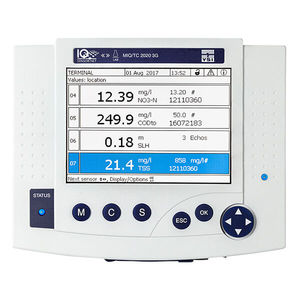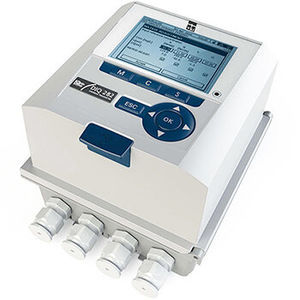
Dissolved oxygen probe IQ SensorNet TriOxmaticcalibrationflowmonitoring
Add to favorites
Compare this product
Characteristics
- Evaluation type
- calibration, flow, dissolved oxygen
- Applications
- monitoring
- Pressure range
10 bar
(145.04 psi)
Description
Digital electrochemical DO sensors with TriOxmatic® electrodes for use with the IQ SensorNet terminals 282/284 and 2020 3G.
The electrochemical method of detecting dissolved oxygen utilizes a semi-permeable membrane, an anode and cathode and an electrolytic solution. The electrical current can be measured and correlates to the oxygen concentration. For accurate results, required conditions include; proper calibration, flow past the membrane, clean electrolyte solution and electrodes, and a clean membrane.
With the TriOxmatic sensors, a 3-electrode patented technology is used. The TriOxmatic sensor functions with a potentiostatically driven 3-electrode system. In terms of measuring technology, this means that two silver electrodes and a gold cathode are in use. One silver anode functions as a non-current bearing reference electrode and the other silver anode is the "live" anode. The reference anode leads to improved signal stability and higher measurement accuracy.
The 3-electrode system also allows for monitoring of the electrolyte supply with the system display capable of indicating when the solution needs to be replaced.
TriOxmatic 700 Series IQ sensors:
SensReg function monitors the electrolytic solution for replacement needs
SensLeak function continually monitors for leakage in the membrane and provides an alert if leakage is detected
Fouling resistant membranes
No "break in" period needed
No long-term drift
Integrated lightning protection
Digital sensor technology retains calibrations
Universal oxygen sensor for measuring and controlling oxygen input in biological wastewater treatment processes.
Catalogs
No catalogs are available for this product.
See all of YSI Inc.‘s catalogsRelated Searches
- Control software
- Temperature probe
- Laboratory software
- Windows software
- Reporting software
- Monitoring probe
- Control analyzer
- Temperature analyzer
- Flow probe
- Environmental analyzer
- Calibration analyzer
- Continuous analyzer
- Calibration probe
- PH meter
- Analyzer with touchscreen
- PH analyzer
- Water analysis analyzer
- Process probe
- Electrochemical electrode
- USB analyzer
*Prices are pre-tax. They exclude delivery charges and customs duties and do not include additional charges for installation or activation options. Prices are indicative only and may vary by country, with changes to the cost of raw materials and exchange rates.





